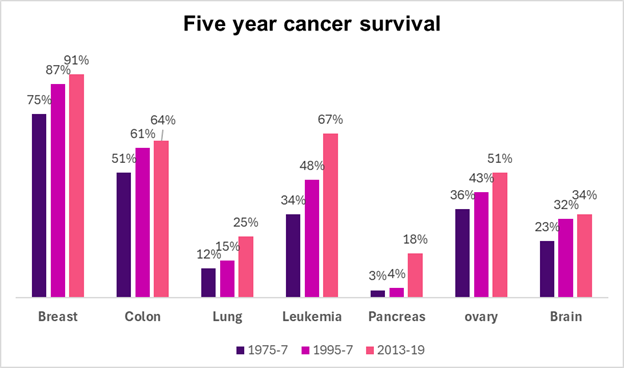Trends in age-adjusted cancer death rates, Males, US 1930-2021
Source: American Cancer Society, Cancer Facts & Figures, 2024 LINK
We often hear about the increase in incidence of cancer in younger people. For instance, colorectal cancer rates among those ages 20 to 24 increased by 185% from 2004-2020. However, the rate of colon cancer in young people remains low even after this increase. The overwhelming majority of colon cancers are still in those over 45, who are recommended to get periodic screening.
We often don’t hear the good news that the age adjusted likelihood of dying of cancer has dropped considerably. Age adjustment is important, as most cancers are more common as we get older. Our aging population alone means that there will be more cases of cancer.
This chart shows five-year survival rates for some of the deadliest cancers.
Source: American Cancer Society, Cancer Facts & Figures, 2024 LINK
Cancer survival rates are increasing partly because of better screening, although most of the increased survival is likely due to better available therapy. Newer chemotherapy agents are expensive but more effective, and more people are eligible for immunotherapy which can suppress previously lethal cancers for months or years, often with only mild side effects. Surgeons are more likely to remove the most dangerous tumors, and radiation therapists are better able to focus on malignancies with less harm to normal tissue.
Implications for employers:
- Employers are purchasing better health outcomes, although costs continue to escalate.
- More plan members need medical care for survivorship, which includes assessing what follow up is appropriate, and dealing with longer term complications from successful cancer treatment.
- Improvements in cancer treatment might make health plan members less reluctant to get evidence-based screening as more people see good clinical results in friends and family members whose cancers were diagnosed early.
- As cancers are detected in younger individuals, fertility preservation and travel benefits may become more relevant to employer populations.
Thanks for reading. You can find previous posts in the Employer Coverage archive
Please subscribe, “like” and suggest this newsletter to friends and colleagues. Thanks!
Coming Tuesday: GLP-1 drugs linked to lower rates of some cancers



One of the important drivers of the increase in overall cancer rates is the success we’ve had in reducing deaths from cardiovascular disease over the past many decades. As cv diseases decline as the #1 and #2 killers , there is an inevitable increase in #3- cancer.
After many decades of only limited progress in making meaningful extensions in cancer patients’ lives, these new approaches are improving cure rates and turning many cancers into chronic diseases.